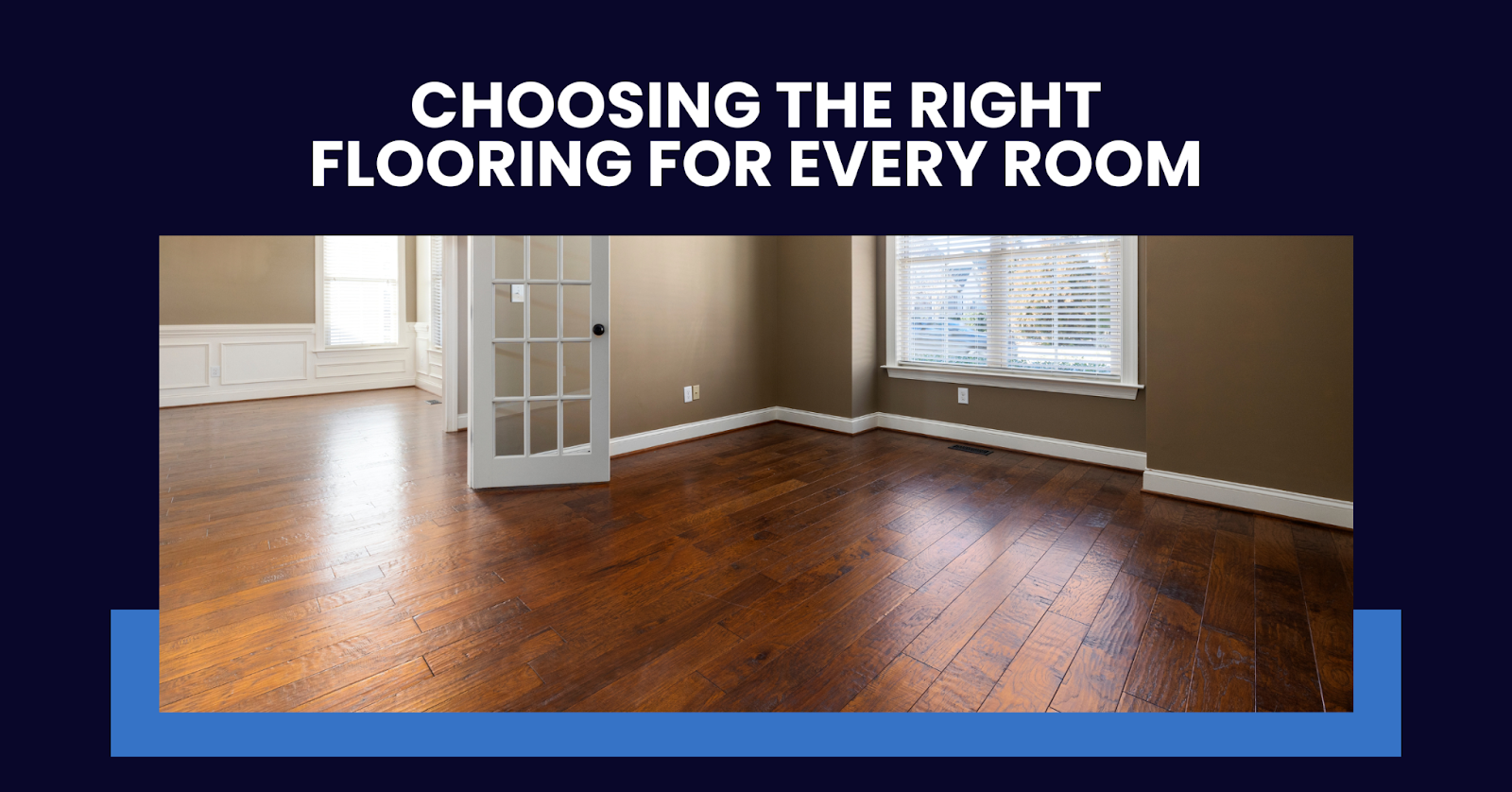A few years ago, Michael moved into his dream home. It had everything they’d hoped for, which brought in plenty of natural light. But as he started to settle in, a common dilemma began to surface. The flooring choices in his new home didn’t match his needs or lifestyle. The hardwood floors he adored in the living room were impractical for the high-traffic hallway, and the bathroom’s tile floors were cold and uncomfortable to walk on.
This problem isn’t unique to Michael. Many homeowners face the challenge of choosing the best flooring for a home that blends both style and function. Finding the perfect flooring for each room can be daunting, but with the right knowledge, it’s possible to make informed decisions that improve both the aesthetic and practicality of your home.
In this blog post, we’ll explore different flooring options, weigh the pros and cons, and provide you with expert advice on how to choose the ideal flooring for each room in your house.
Understanding the Basics of Flooring Types
Hardwood Flooring: A Timeless Choice
Hardwood flooring has always been a popular choice for homeowners. Its natural beauty and durability make it a standout option for living rooms, bedrooms, and even hallways. Hardwood floors offer a classic, elegant look and can be refinished to restore their beauty over time.
But before committing to hardwood floors, it’s important to consider the environment of the room. Hardwood can be prone to scratches and water damage, making it less suitable for high-moisture areas like bathrooms or kitchens. If you love the look of hardwood but need a more durable alternative, consider engineered wood floors, which offer the same aesthetic but with improved moisture resistance.
Key Benefits of Hardwood Flooring:
- Timeless appeal
- Can be refinished
- Adds value to your home
- Warmth and natural texture
Tile Flooring: Practical and Durable
When it comes to durable flooring options, tile is hard to beat. It is water-resistant, durable, and easy to maintain, making it an ideal choice for high-moisture areas such as bathrooms, kitchens, and laundry rooms. Tile comes in a variety of materials, including ceramic, porcelain, and natural stone, giving homeowners plenty of options to choose from.
Tile is particularly popular for its versatility. It can be used to create a variety of styles, from sleek, modern designs to rustic, Mediterranean-inspired looks. The main drawback, however, is that tile floors can be cold and hard underfoot, especially in areas without radiant heating.
Key Benefits of Tile Flooring:
- Water-resistant
- Low maintenance
- Long-lasting
- Versatile design options
Carpet Flooring: Soft and Cozy
Carpet is another common flooring option, offering comfort, warmth, and sound insulation. It’s ideal for bedrooms, living rooms, and home offices where comfort is a priority. With numerous styles, colors, and textures available, carpet can complement a wide range of interior designs.
While carpet adds warmth and comfort, it also requires regular maintenance. It can trap dirt, dust, and allergens, making it less than ideal for people with allergies or for high-traffic areas. If you’re considering carpet, think about the room’s function and whether you can commit to regular cleaning.
Key Benefits of Carpet Flooring:
- Comfort and warmth
- Soundproofing qualities
- Wide variety of styles
- Ideal for bedrooms and living rooms
Laminate Flooring: Affordable and Stylish
Laminate flooring offers the look of hardwood or tile but at a more affordable price point. It is durable, easy to install, and resistant to stains and scratches, making it a great choice for busy families or homeowners on a budget. Laminate floors can be used in almost any room, though they are best suited for areas with moderate foot traffic.
One thing to keep in mind is that laminate flooring can’t be refinished like hardwood. Over time, the surface may show signs of wear and tear. However, modern laminate products have made significant strides in terms of quality and aesthetics, closely mimicking natural materials like wood and stone.
Key Benefits of Laminate Flooring:
- Budget-friendly
- Resists stains and scratches
- Easy to install
- A wide variety of design options
Comparing Hardwood vs Tile
Understanding the differences between hardwood vs tile can guide your decision-making when choosing the right flooring for each room.
| Feature | Hardwood | Tile |
| Durability | Prone to scratches and dents | Highly durable and scratch-resistant |
| Water Resistance | Susceptible to water damage | Excellent water resistance |
| Maintenance | Requires regular upkeep | Easy to clean and maintain |
| Comfort | Warm and comfortable underfoot | Can be cold and hard |
| Installation | More complex and time-consuming | Easier, especially with modern tiles |
Room-by-Room Flooring Recommendations
Now that we’ve explored the pros and cons of various flooring types, let’s go room by room and examine which flooring is best suited for each area.
Living Room
The living room is often the most used spamost-used home. It’s where your family gathers, where you entertain guests, and where you relax after a long day. Comfort and style are essential here.
- Recommended: Hardwood or engineered wood provides warmth, elegance, and a timeless look that’s perfect for living areas. Engineered wood is an excellent choice if you’re concerned about moisture or fluctuating temperatures.
- Alternative: Laminate flooring can offer a similar look to wood, with greater affordability. It’s easy to clean and maintain, but it might not provide the same warmth or richness as real wood.
- Avoid tile, as it can feel cold and uninviting, especially in the winter months. It’s better suited for kitchens and bathrooms.
Kitchen
Kitchens face heavy foot traffic and are often exposed to spills and stains. Flooring in this room must be durable, easy to clean, and moisture-resistant.
- Recommended: Tile, especially porcelain or ceramic, is an excellent option due to its water resistance and durability. It’s easy to clean and maintain, which is ideal for a space where spills happen often.
- Alternative: Vinyl flooring is another excellent choice, offering water resistance and ease of cleaning while mimicking the look of tile or wood.
- Avoid: Hardwood is not ideal for kitchens due to its vulnerability to water damage. Even with sealing, it can be prone to moisture absorption.
Bathroom
Bathrooms are the most moisture-prone areas in the home, so flooring here needs to be waterproof and slip-resistant.
- Recommended: Tile, especially textured varieties or slip-resistant tiles, is a great choice for bathrooms. It’s waterproof, easy to maintain, and comes in various styles to match your design preferences.
- Alternative: Vinyl flooring is another moisture-resistant option that also provides warmth underfoot compared to tile. It’s also easier to install and is available in a wide variety of designs.
- Avoid carpet and hardwood, as these materials can trap moisture, leading to mold, mildew, and rot.
Bedroom
Comfort and insulation are key considerations in the bedroom. A cozy atmosphere is essential for restful sleep.
- Recommended: Carpet is often the preferred choice for bedrooms due to its softness, warmth, and noise-reducing properties. It helps create a cozy environment for relaxation.
- Alternative: Hardwood or engineered wood with area rugs can also work well, providing a more sophisticated look while still offering comfort and warmth.
- Avoid: Tile is too hard and cold, making it less suitable for a bedroom, which requires a more cushioned, warm environment.
Basement
Basements often have higher humidity levels, so the flooring you choose must be moisture-resistant and durable.
- Recommended: Vinyl or tile flooring works well in basements, offering water resistance and durability. These materials are easy to clean and maintain and won’t warp or deteriorate in a damp environment.
- Alternative: Engineered wood can work if your basement is dry, as it’s more moisture-resistant than solid hardwood.
- Avoid: Carpet and hardwood are not recommended for basements due to their susceptibility to moisture damage and mold growth.
Smart Floors, Smarter Homes: Home Improvement Tips
- Start from the floor up — Flooring is a foundational upgrade that instantly transforms any space.
- Match lifestyle to material — Kids, pets, or high-traffic? Go for vinyl or tile. Prefer cozy? Think carpet for bedrooms.
- Function meets style — Choose flooring that looks great and works for your daily routine.
- Think long-term — Invest in flooring that holds up over time, not just what’s trending today.
- Plan before you purchase — Measure twice, compare materials, and consult a pro when in doubt.
FAQs
What is the best Durable flooring option for homes with pets?
Flooring options like laminate, vinyl, and tile are durable and resistant to pet scratches and spills. They are easier to clean and maintain, making them ideal for homes with pets.
How can I prevent my hardwood floors from scratching or denting?
To protect hardwood floors, use furniture pads and area rugs, and avoid high heels or heavy furniture. Regularly cleaning and refinishing can also help preserve their appearance.
Is radiant floor heating compatible with all flooring types?
Not all flooring types are compatible with radiant heating; hardwood, tile, and certain vinyl options work best. Carpets or thick area rugs may insulate too much and reduce heating efficiency.
How do I maintain my tile floors to prevent grout discoloration?
Regularly cleaning with a gentle, non-abrasive cleaner and sealing the grout can help prevent discoloration. Avoid harsh chemicals that can damage the grout and tile surface.
Can I install new flooring over existing flooring, or does it need to be removed first?
In many cases, you can install new flooring over the old one, but it depends on the existing floor’s condition and the type of new flooring. Confirm the surface is level and clean to avoid complications.
Conclusion
Choosing the right flooring for each room in your home is an important decision that impacts both the aesthetic and functionality of your space. Whether you opt for hardwood in the living room, tile in the bathroom, or carpet in the bedroom, it’s essential to consider the room’s purpose, durability needs, and overall style. When planning a custom home renovation, selecting durable flooring options ensures your investment stands up to daily wear while enhancing the beauty of your home. By choosing the best flooring for your home based on these factors, you can confirm that your flooring not only looks great but also stands the test of time.
Ready to transform your home with the perfect flooring? Schedule your visit today and let us help you find the ideal solution for your space!





